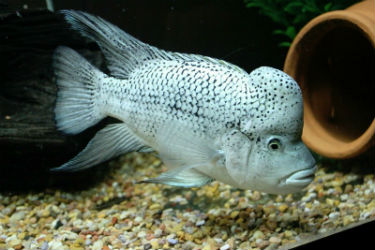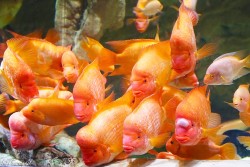Black nasty cichlid tank mates (Nandopsis haitiensis)
 Welcome to the enchanting world of Nandopsis haitiensis, a species that reigns supreme in the aquatic landscapes of Haiti's freshwater bodies. Displaying a remarkable symphony of colors, this fish catches the eye with its captivating blend of vivid pigments that range from striking blues and vibrant yellows to subtle hints of earthy tones. Its physical features are equally captivating, as its streamlined body is adorned with intricate patterns and markings unique to each individual. From its distinctively arched dorsal fin to its slightly protruding lower jaw, Nandopsis haitiensis exudes an air of elegance that sets it apart from its aquatic counterparts.
Welcome to the enchanting world of Nandopsis haitiensis, a species that reigns supreme in the aquatic landscapes of Haiti's freshwater bodies. Displaying a remarkable symphony of colors, this fish catches the eye with its captivating blend of vivid pigments that range from striking blues and vibrant yellows to subtle hints of earthy tones. Its physical features are equally captivating, as its streamlined body is adorned with intricate patterns and markings unique to each individual. From its distinctively arched dorsal fin to its slightly protruding lower jaw, Nandopsis haitiensis exudes an air of elegance that sets it apart from its aquatic counterparts.Nandopsis haitiensis tankmates include big cichlids like A. ocellatus or Oscar cichlids, R. octofasciata known as Jack Dempsey cichlids, A. citrinellus the Midas cichlid sometimes called the Red Devil, T. meeki known as the Firemouth cichlid, P. managuense the Jaquar cichlid, and other similarly aggressive cichlids but not limited to cichlids. Example you can keep them with Arowana, or Datnoides. It's just a matter of balancing the community with the right mix of fish.
Name: Black Nasty
Other Names: Odo, Haitian Cichlid, Haitiensis
Scientific Name: Nandopsis haitiensis
Family: Cichlidae
Distribution: The two island nations on Hispaniola.
Length: 16" is an absolute maximum, but 12"-14" might be more reasonable for aquarium maximums.
Water Temperature: 73 to 82 degrees Fahrenheit (23-28 degrees Celsius)
Diet: Most low-protein foods are taken with gusto. High-protein foods (especially those which are derived from animals) should be avoided (or given in small amounts) as these fish are highly-susceptible to bloat. Many suggest giving them mostly (or exclusively) plant matter, despite the fact that these fishes eat "turret shells" (some sort of snail) in the wild.
Water Chemistry: Most hardness ranges from moderately hard to very hard will probably suffice for their care.
pH: 6-8
Lifespan: Probably 8-10 years like some of its congeners and closely-related fishes.
Species Description: These are large plump, typically-shaped cichlids with the fins typically associated with this family of fish. The coloration is not necessarily spectacular as Odos seem to have a base coloration of gray to gray-green with black speckles on top. Some fins are a little greener than the base coloration, while others have the same shade as the base coloration on them and the black speckling shade on the rays thereof.
Species Behavior: This is where the Black Nasty gains its name and fame. These are aggressive fish which rarely congregate in more than pairs in the wild and don't do well together in aquaria. Any fish which can be bullied by a Haitiensis is more than likely to be bullied by a Haitiensis.
These are inveterate diggers which won't hesitate to move aquarium decor that isn't situated to their liking. They also have aggression issues with regard to the red pilot light of a glass heater; either cover the heater, remove it from the reach of the Haitian Cichlid or replace it with one that does not have a light indicating the status of that piece of equipment.
Natural Conditions Lakes and streams. They do spend a lot of time in open water, but they also maintain hidey-holes in rockwork- and debris-laden areas in which they can take cover. Young N. haitiensis are often found in aquatic vegetation.
Natural Range The two island nations on Hispaniola.
Minimum recommended tank size 75 gallons
Water Temperature 73 to 82 degrees Fahrenheit (23-28 degrees Celsius)
Water Quality Most harnesses from moderately hard to very hard will probably suffice for their care, so long as the water is within one pH degree of neutral.
Sexing Females are smaller but darker in coloration. The nuchal hump, often considered solely the domain of virile male cichlids, doesn't necessarily denote a difference in sex in N. haitiensis.
Breeding: Like many of the other large "Central American" Cichlids, these are open spawners who like to have access to a large flat rock for that purpose. Both parents care for the fry and will viciously attack any intruders in their territory. An extremely large spawning tank should be used and it should be riddled with retreats (but don't forget the open water component) so that spousal abuse is minimized by the ability of one to escape the other. Target fishes may be necessary for the survival of the pair.
The young may be fed baby brine shrimp at birth, but weaning them to foods with less animal protein component may be necessary for their long-term health.
Feeding: Most low-protein foods are taken with gusto. High-protein foods (especially those which are derived from animals) should be avoided (or given in small amounts) as these fish are highly-susceptible to bloat. Many suggest giving them mostly (or exclusively) plant matter, despite the fact that these fishes eat "turret shells" (some sort of snail) in the wild.




